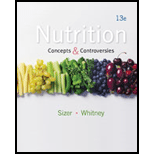
Nutrition: Concepts and Controversies
13th Edition
ISBN: 9781133603184
Author: Frances Sizer, Ellie Whitney
Publisher: Cengage Learning
expand_more
expand_more
format_list_bulleted
Question
Chapter 5, Problem 21SC
Summary Introduction
Introduction:
Very low-fat diets is the diet which include only 10% or less calorie. It tends to have 20% of protein content and 80% of carbohydrate content.
Expert Solution & Answer
Trending nowThis is a popular solution!

Chapter 5 Solutions
Nutrition: Concepts and Controversies
Knowledge Booster
Similar questions
- Bile has a role in _________ digestion and absorption. a. carbohydrate c. protein b. fat d. amino acidarrow_forwardAs a person ages, the number of body cells steadily decreases and energy needs decline. If you were planning an older persons diet, what kind(s) of nutrients would you emphasize, and why? Which ones would you recommend an aging person eat less of?arrow_forwardSome nutritionists claim that the secret to long life is to be slightly underweight as an adult. If a persons weight is related partly to diet, partly to activity level, and partly to genetics, what underlying factors could be at work to generate statistics that support this claim?arrow_forward
Recommended textbooks for you

 Comprehensive Medical Assisting: Administrative a...NursingISBN:9781305964792Author:Wilburta Q. Lindh, Carol D. Tamparo, Barbara M. Dahl, Julie Morris, Cindy CorreaPublisher:Cengage LearningEssentials of Pharmacology for Health ProfessionsNursingISBN:9781305441620Author:WOODROWPublisher:Cengage
Comprehensive Medical Assisting: Administrative a...NursingISBN:9781305964792Author:Wilburta Q. Lindh, Carol D. Tamparo, Barbara M. Dahl, Julie Morris, Cindy CorreaPublisher:Cengage LearningEssentials of Pharmacology for Health ProfessionsNursingISBN:9781305441620Author:WOODROWPublisher:Cengage




Comprehensive Medical Assisting: Administrative a...
Nursing
ISBN:9781305964792
Author:Wilburta Q. Lindh, Carol D. Tamparo, Barbara M. Dahl, Julie Morris, Cindy Correa
Publisher:Cengage Learning


Essentials of Pharmacology for Health Professions
Nursing
ISBN:9781305441620
Author:WOODROW
Publisher:Cengage